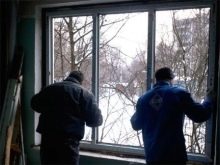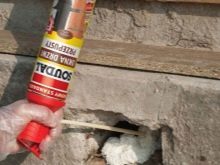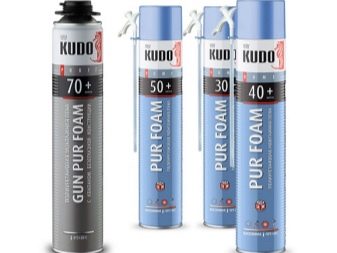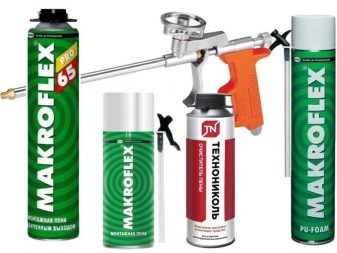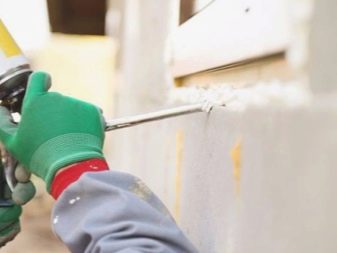Choosing assembly foam for work at sub-zero temperatures

Polyurethane foam or polyurethane spray insulation is considered one of the most popular ways to seal joints and seals. Builders and decorators often use it for repairs, noting the convenience and ease of use. But when choosing a material it is necessary to take into account weather conditions, season and other factors that can affect the quality of installation. In the cold season it is better to use a special foam for work at sub-zero temperatures.
Special features
The quality of work of the master directly depends on the characteristics of building materials. Several years ago, when installing plastic windows and exterior doors, builders actively closed the gaps with summer mounting foam. Consumers noted that during the past 1-2 cold seasons, the joints began to blow, drafts occurred, and the temperature in the room fell.When analyzing the problem, it turned out that the sealant has lost its properties, it has become so porous that it hardly keeps the structure.
The reason lies in the wrong selection of foam. Standard series are designed for a temperature range from -10 ° to + 30 ° C. With a harsh winter, the structure of the sealant is broken, it allows water and air to pass through. The sealant is destroyed faster, therefore it requires mandatory insulation with a layer of grout, putty and paint. In winter conditions it is better to select special types of material adapted for more extreme conditions.
Polyurethane foam for work at a minus temperature has a number of features:
- easily transfers drops from -50 ° to + 80 ° С;
- does not thicken at installation on a light frost;
- it hardens equally quickly in cold or heat;
- has excellent thermal conductivity and sound insulation;
- allows you to save up to 10% of the heat in the room.
The appearance of winter foam has made it easier for many builders. With its help, you can carry out installation work in cold weather, perform an emergency installation of the window unit at low temperature. But the choice should be approached more carefully,study the characteristics and strictly adhere to the recommendations of experienced professionals.
Kinds
Polyurethane foam is a thick prepolymer based on durable polyurethane foam. Under high pressure, the mass is in a metal container with a dispenser. The main reaction takes place upon contact with air: particles of the sealant instantly expand and take on the shape needed by the builder, increasing in volume by several times at once. Working with this material is not difficult, and the rapid process of solidification allows not to delay the installation of the object for several days.
Conventionally, all types of foam can be divided into household and professional. The first is characterized by a small package size, has simple and universal characteristics. The cylinder is immediately equipped with a nozzle for spraying. Series for use by builders are made under the mounting gun - a small device that allows you to penetrate the narrow holes, it is better to control the amount of foaming. It is simply indispensable when installing a window unit, assembling a balcony or other complex works.
The main types of foam that are produced in the market of building materials:
- summer, suitable for work in warm conditions from May to October;
- low-temperature, intended for installation in the winter;
- All-season or universal, the working temperature of which ranges from -10 ° to + 50 ° С.
If you have to carry out installation or construction at a facility with a high fire hazard, experts recommend using high-temperature foam. It is designed from high-quality polymers that do not burn even in an open flame. This allows you to restrain the flow of air in case of fire, ensures the stability of any design. Such material can be used in school institutions, shopping centers and hospitals, to warm saunas.
What temperature will stand?
The instructions of most manufacturers specified temperature range from -18 ° C. This is a kind of boundary for solidification and compaction of the mass. In fact, experienced builders know that degrees directly influence not only the installation conditions. The amount of foam that a balloon of the same volume produces is directly dependent on the weather mode: at ambient temperatures of -10 ° C, the output will be 50% less than at + 20 ° C.
It is more important to understand what kind of negative temperature the winter foam can withstand. The use of specialized series is necessary if it is intended to operate a construction object in the cold season. When applied correctly, it transfers frost down to -35 ° C without loss of thermal conductivity and fixing properties. Some manufacturers separately specify the maximum degree of the surface to which the polymer is applied.
Quality material keeps its shape and is absolutely safe in conditions that threaten to ignite: near fireplaces and stoves, in the window openings of the kitchen near the stove.
Scope of application
Polyurethane foam, designed to work in the cold season, has a high adhesion. This provides fast adhesion to the surface, excellent fixation after a few hours.
When exterior and interior mounting material is used for the following purposes:
- fixing parts of large window frames or door jambs;
- mounting plates for wall insulation;
- sealing gaps between the seams and joints on the outside of the building;
- closing the seams in a wooden sauna instead of tow;
- thermal insulation of heating or cooling systems in the house, at a manufacturing plant.
Winter foam is indispensable for sealing holes in the wall when removing the pipe from the steam room or air conditioner hose. She is not afraid of the difference in temperature outside and indoors, well isolates extraneous sounds.
Often the need for such a material arises in the period of late autumn and winter, when, after heavy rains, the moisture accumulated in the concrete floors expands and wide cracks and faults are formed. This allows for urgent repairs and to protect the home from heat loss.
Tips and tricks
On the market you can find a huge number of samples of winter foam for construction work. It differs not only in price, but also in temperature conditions. Therefore, before buying, you should read the instructions on the container, not relying on the tips of the seller. Good help provide feedback from colleagues or users. Some experts recommend preheating the material slightly to ensure a more uniform yield and large volume.
It is possible to use winter foam already at + 10 ° С.
Skilled masters reveal several secrets that allow you to do the job qualitatively and easily.
- The balloon should be shaken with unhurried movements so that the mass inside is evenly distributed.
- To improve adhesion, the surface can be slightly moistened with ordinary water. So polyurethane foam will lay down more accurately and firmly connect the details.
- If the temperature outside has fallen to + 5 ° С, before carrying out the work the bottle is dipped in warm water (not hot) for 10-15 minutes.
- Winter foam hardens for at least 6 hours. Experts recommend to close large gaps in several steps, imposing a new layer after drying. So the seam will be perfectly sealed and will last for many years without any complaints.
When working in the cold, it is necessary to purchase only winter foam with a high degree of performance. Even an experienced builder will not be able to calculate the volume at given levels of humidity and frost. In order not to face a shortage of mounting material during the installation process, it should be purchased 20–30% more from the estimated standard.
It is not recommended to purchase a large amount of winter foam for the future, paying attention to the attractive promotions and discounts of building supermarkets. On average, the storage period when the container is closed must not exceed one year fromproduction of goods. Otherwise, the properties greatly deteriorate, reduced resistance to moisture. After opening and using part of the bottle, it must be completely emptied in 30 days.
Another significant plus of winter foam is its versatility. In contrast to the summer type of material, winter foam shows excellent bonding properties at any time of the year. In the warm season, it gives an increased volume, faster freezes. If it was not possible to fully use the cylinder in the fall, it can be stored until spring, to work on any installation and installations in the heat.
For information on how to use foam and gun, see the following video.


